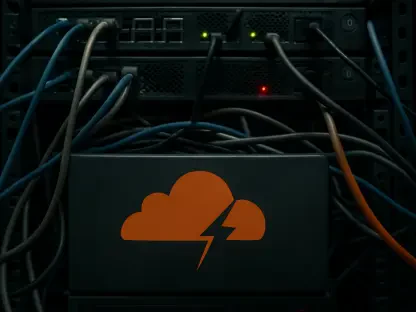The year 2024 presents a rapidly evolving cyber-threat landscape that organizations must navigate with vigilance. A comprehensive examination by Forescout Research – Vedere Labs reveals distinct cyber risks across various categories of connected devices. From Information Technology (IT) infrastructure to the Internet of Medical Things (IoMT), the findings underscore the increasing vulnerability and critical importance of securing these devices. Current trends highlight an urgent need for holistic approaches to cybersecurity, given the complex nature of the threats that continue to emerge.
Rising Threats Among IT Devices
IT devices continue to pose significant risks to organizations. While there has been a reduction in known vulnerabilities overall, network infrastructure such as routers and wireless access points remain highly susceptible to attacks. These devices serve as crucial gateways for network communication, making them prime targets for cybercriminals. The essential role that these devices play in maintaining network integrity means that their compromise can have far-reaching consequences, affecting the entire IT infrastructure.
Another category of concern includes hypervisors, which manage virtual machines. Hypervisors are attractive to ransomware attackers due to the potential to impact multiple environments simultaneously, amplifying the damage. This makes hypervisors a lucrative target for threat actors who aim to maximize disruption. Additionally, servers and computers, despite extensive security measures, continue to be focal points for cyber threats, underscoring the persistent risk these foundational components of IT infrastructure present.
Vulnerabilities in IoT Devices
IoT devices are showing a substantial increase in vulnerabilities in 2024. Network video recorders (NVRs) are now included in the high-risk category, sharing exposure risks similar to IP cameras and VoIP devices. IoT devices often lack robust security measures, making them easy targets for attackers. Additionally, the sheer number and diversity of IoT devices deployed across various environments increase the attack surface, providing cybercriminals with numerous entry points to exploit.
Network-attached storage (NAS) devices are particularly appealing to ransomware actors due to their data-rich content. Similarly, printers continue to be underestimated in terms of security vulnerabilities, despite their integral role in workplace networks. These devices often have access to sensitive information, making them effective launchpads for broader cyber attacks. The increase in IoT vulnerabilities highlights the urgent need for enhanced security protocols and practices to protect these ubiquitous devices.
Critical Operational Technology (OT) Devices
OT devices are critical to infrastructure and thus present prime targets for cyber attacks. Uninterruptible power supplies (UPS) and distributed control systems (DCS) have seen heightened risks. These devices are essential in maintaining operational continuity and managing industrial processes, but they are often insecurely designed. The reliance on legacy systems and the intrinsic design flaws make these devices vulnerable to sophisticated threats, which can lead to significant disruptions in operations.
Programmable logic controllers (PLCs), robotics, and building management systems are equally vulnerable. These systems lack adequate protective measures, making them susceptible to disruptions that could severely impact production and operational stability. Given their critical importance in industrial and manufacturing contexts, the exploitation of these devices can result in substantial economic and productivity losses. Therefore, strengthening security measures for OT devices is integral to safeguarding critical infrastructure.
Emerging Threats in Internet of Medical Things (IoMT)
Healthcare’s IoMT devices have an evolving risk profile with new entries posing significant threats. Medical information systems, electrocardiographs, DICOM workstations, PACS, and medication-dispensing systems are now considered high-risk. Their vulnerabilities directly affect patient care and data security. The interconnectivity of these devices, combined with their critical role in medical procedures and administration, makes them prime targets for cyber attacks.
Medical information systems store critical clinical data, and thousands are exposed online, compromising sensitive information. Electrocardiographs, which monitor heart activity, can be life-threatening if delayed due to operational issues. Similarly, DICOM workstations used for storing and transmitting medical images and PACS systems managing these images exhibit security gaps, risking data breaches. Medication-dispensing systems, crucial for administering patient treatments, can seriously disrupt healthcare services if compromised. These vulnerabilities highlight the immense stakes involved in securing IoMT devices.
Dynamic and Evolving Threat Landscape
As cyber threats evolve, attackers are shifting strategies. The focus has moved towards targeting network infrastructure devices rather than just traditional endpoints. This trend underscores the need for organizations to adapt their security measures to address emerging vulnerabilities continuously. Cybercriminals are increasingly sophisticated, leveraging advanced techniques to exploit weaknesses in essential network components, which necessitates ongoing vigilance and adaptive security strategies.
Alerts from agencies like the Cybersecurity and Infrastructure Security Agency emphasize the sophisticated nature of threats faced by OT environments, such as those posed by Volt Typhoon. These threats demand proactive defense mechanisms to protect essential systems. Similarly, the healthcare sector’s vulnerabilities highlight the constant evolution of cyber threats, requiring continuous improvements in security measures to safeguard critical patient data and healthcare operations.
Comprehensive Risk Management Approach
2024 brings a swiftly changing cyber-threat landscape that demands organizations stay alert and proactive. An in-depth study by Forescout Research – Vedere Labs has identified various cyber risks linked to different categories of connected devices. From Information Technology (IT) infrastructure to the Internet of Medical Things (IoMT), the study highlights the growing vulnerabilities and the essential need to secure these devices. Current trends emphasize the urgency of adopting comprehensive cybersecurity strategies due to the intricate nature of evolving threats. With cyber risks becoming more sophisticated, a holistic approach to cybersecurity is more critical than ever. Such an approach requires constant vigilance, advanced technology, and a proactive stance to shield sensitive data and maintain operational integrity. The findings of this study are a crucial reminder that as our dependency on technology deepens, so too must our commitment to protecting it against escalating cyber threats.









